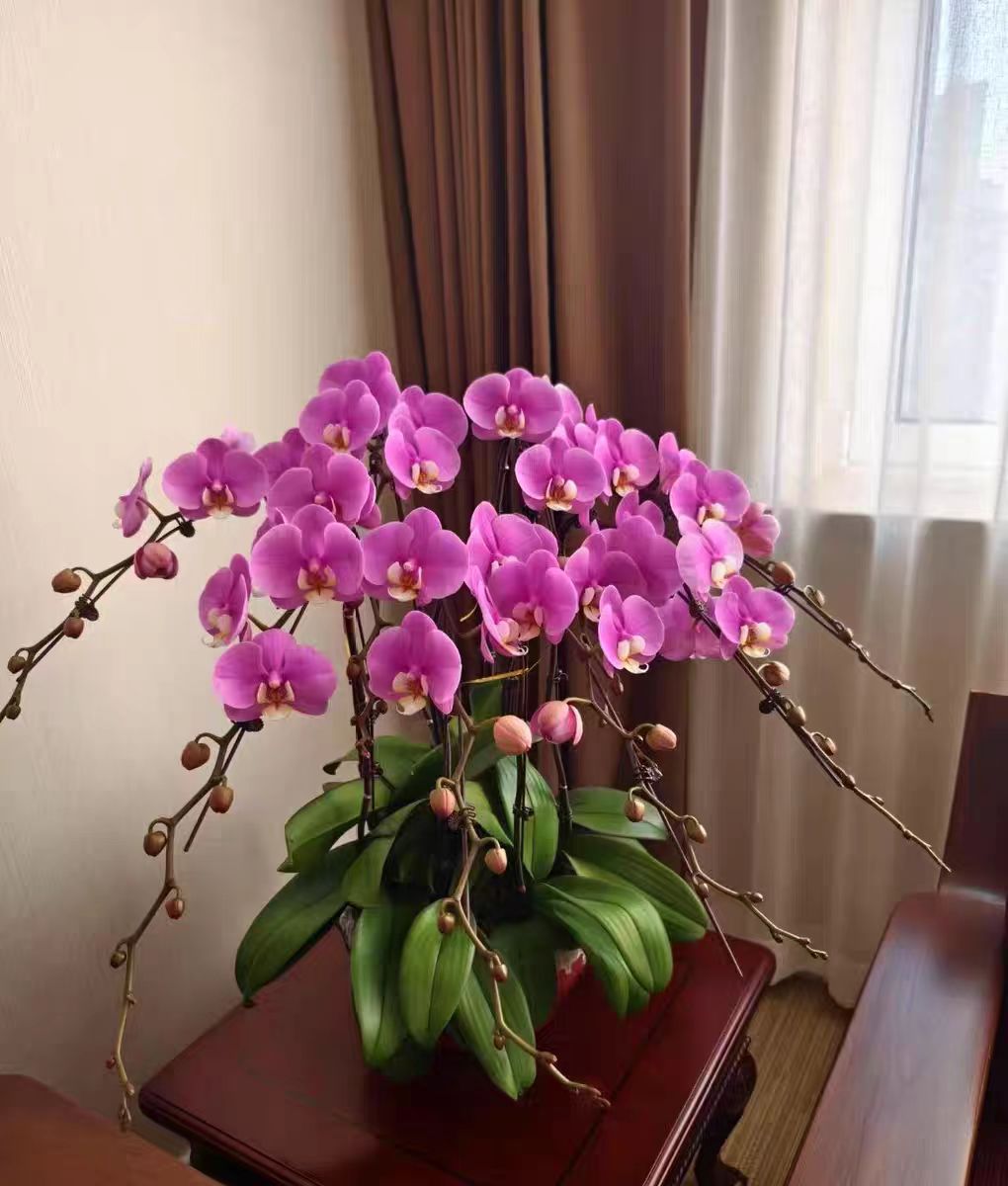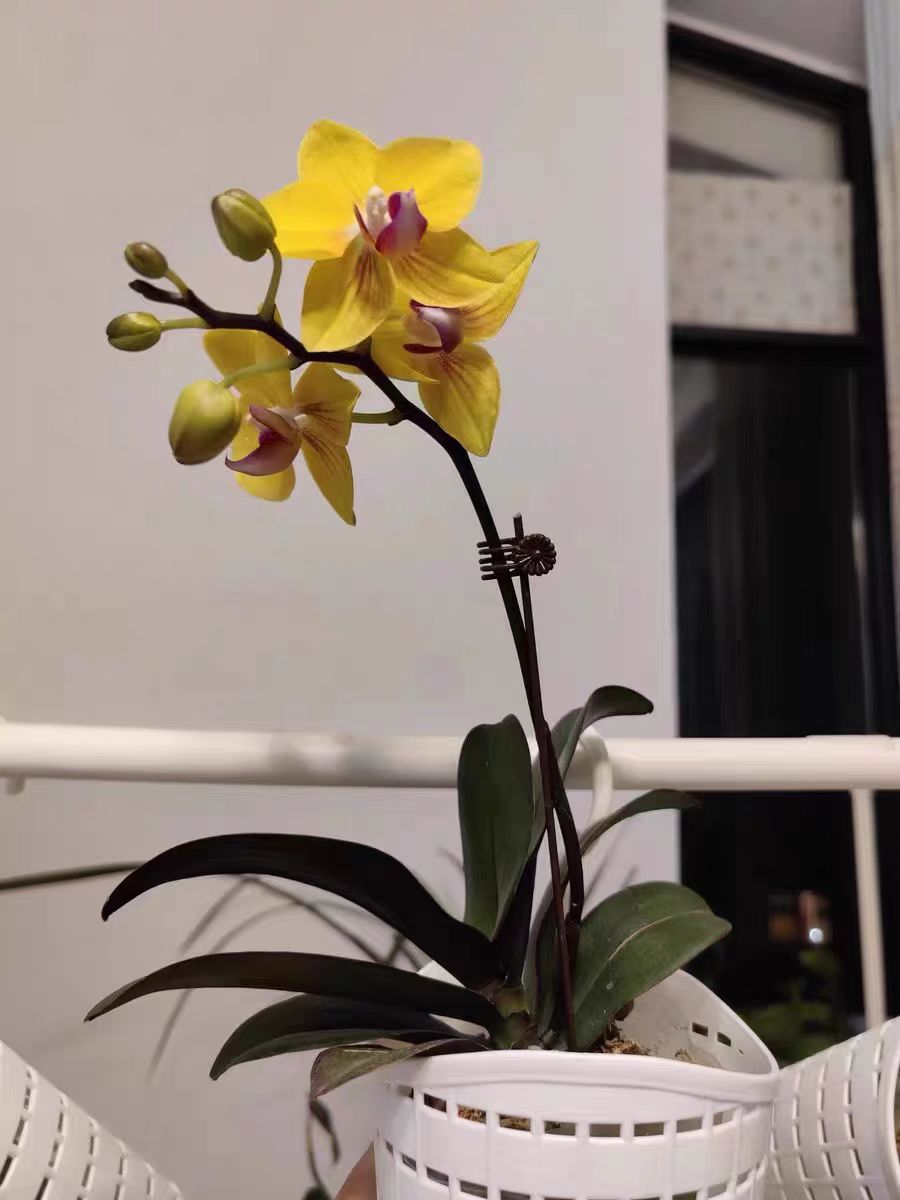The phalaenopsis orchid is known as the "Queen of Orchids." It has a beautiful flower shape and gorgeous colors. Many people, after potting the phalaenopsis orchid in the soil, affect its growth due to improper management. Only by mastering the correct methods can it grow healthily in the pot and bloom as scheduled.
The phalaenopsis orchid has special requirements for light. It prefers diffused light and avoids direct strong light. In the initial stage after planting in the soil, the plant is relatively fragile and should be placed in a place with bright diffused light, such as a position indoors near the window where the sunlight does not directly shine. As it grows, the light exposure time can be gradually increased. However, when the light is too strong in summer, a shading treatment of 50%-70% must be carried out. Otherwise, the leaves are easily burned, developing yellow spots or even drying out. If there is insufficient light, the plant will grow slowly and the flower color will be dull. In spring, autumn, and winter, the phalaenopsis orchid can receive more gentle sunlight to promote photosynthesis and accumulate nutrients.
Temperature Control: The phalaenopsis orchid is suitable for growing in a warm environment, and the most suitable temperature is between 15°C and 28°C. After planting in the soil, the change of the environmental temperature needs to be constantly monitored. In the hot summer, when the temperature exceeds 32°C, the growth of the phalaenopsis orchid will be inhibited. Cooling measures should be taken, such as strengthening ventilation and spraying water on the surrounding ground. In winter, good heat preservation work should be done. When the temperature is lower than 10°C, the plant is prone to frost damage. It can be moved to a warm indoor place, and if necessary, a heating device can be used to maintain the appropriate temperature. A certain temperature difference between day and night is more conducive to the accumulation of nutrients and the growth of the plant. Generally, a temperature difference of 5°C to 8°C is appropriate.
Water Management: Watering is a key part of the management of potted phalaenopsis orchids. After planting in the soil, watering should not be done blindly. Follow the principle of "water when the soil is dry and then let it dry out again." Insert your finger 2-3 centimeters into the potting soil. If it feels dry, it is necessary to water. Water thoroughly until the water flows out from the drainage holes at the bottom of the pot, but there should be no water accumulation, otherwise, it is easy to cause root rot. The frequency of watering varies in different seasons. In the hot summer, water evaporates quickly, and it is necessary to water once every 2-3 days. In the cold winter, the plant grows slowly, and watering once every 7-10 days is enough. In addition, air humidity is also very important for the growth of the phalaenopsis orchid. It is advisable to keep it between 60% and 80%. You can increase the air humidity by spraying water around the plant or using a humidifier.
Fertilization: After the phalaenopsis orchid is planted in the soil, reasonable fertilization can promote its growth. During the vigorous growth period, such as in spring and autumn, apply a thin liquid fertilizer every 1-2 weeks, mainly nitrogen fertilizer, with an appropriate amount of phosphorus and potassium fertilizers to promote the growth of branches and leaves. Before the flowering period, increase the amount of phosphorus and potassium fertilizers, such as potassium dihydrogen phosphate, which is diluted into a 1000-1500 times solution. Spray the foliar fertilizer or pour it on the roots once every 7-10 days, which can promote flower bud differentiation and increase the number of flowers and the flower color. When the temperature is too high in summer and too low in winter, the plant grows slowly or goes dormant, and fertilization should be reduced or stopped to avoid fertilizer damage caused by the accumulation of fertilizers.
Daily Inspection and Pest and Disease Control: Regularly inspecting the phalaenopsis orchid plant is very necessary. Check whether there are signs of yellowing, drying, pests, and diseases on the leaves, and find and deal with problems in a timely manner. Common diseases of the phalaenopsis orchid include anthracnose, soft rot, etc., which are mostly caused by poor ventilation and high humidity. Keeping the maintenance environment well-ventilated and reducing the air humidity can effectively prevent the occurrence of diseases. In the early stage of the disease, cut off the diseased leaves in time and spray fungicides such as carbendazim and thiophanate-methyl for prevention and treatment. Common pests include spider mites, aphids, etc., which can be controlled by spraying insecticides such as imidacloprid and abamectin. Pay attention to diluting and using them according to the instructions to avoid harming the plant due to excessive concentration.
Precautions for Repotting:
The phalaenopsis orchid grows relatively fast, and it generally needs to be repotted once every 1-2 years. The best time for repotting is after the flowers wither in spring, when the plant has a strong ability to resume growth. When repotting, gently take out the plant and remove part of the old substrate, being careful not to damage the roots. Select a slightly larger pot with good air permeability and fill it with a new substrate, such as moss, bark, etc. After repotting, water it thoroughly and place it in a cool and well-ventilated place for about a week to slow down the seedling, and then gradually resume normal maintenance.
The management of potted phalaenopsis orchids after planting in the soil requires flower enthusiasts to take careful care. They need to pay attention to aspects such as light, temperature, water, fertilization, and pest and disease control. Only in this way can the phalaenopsis orchid thrive in the pot and bring us the beautiful sight of a profusion of flowers.
How to Manage the Potted Phalaenopsis Orchid After Planting It in the Soil?

Share with
Tagged in :



Leave a Reply